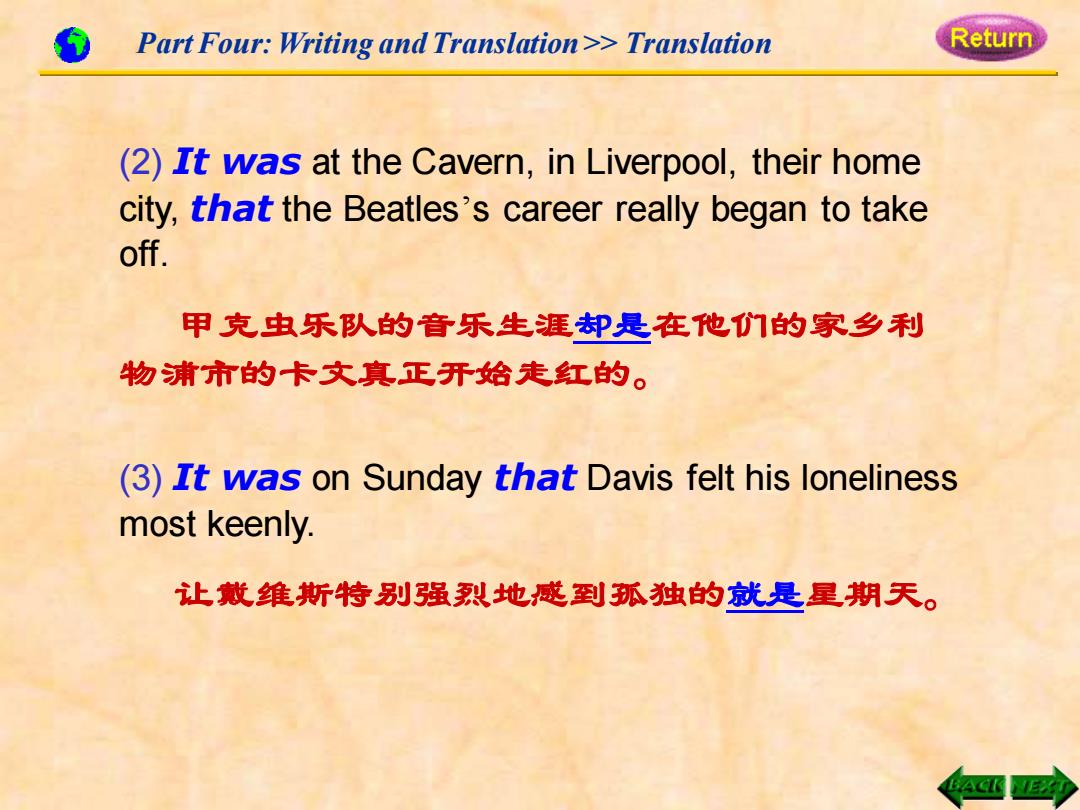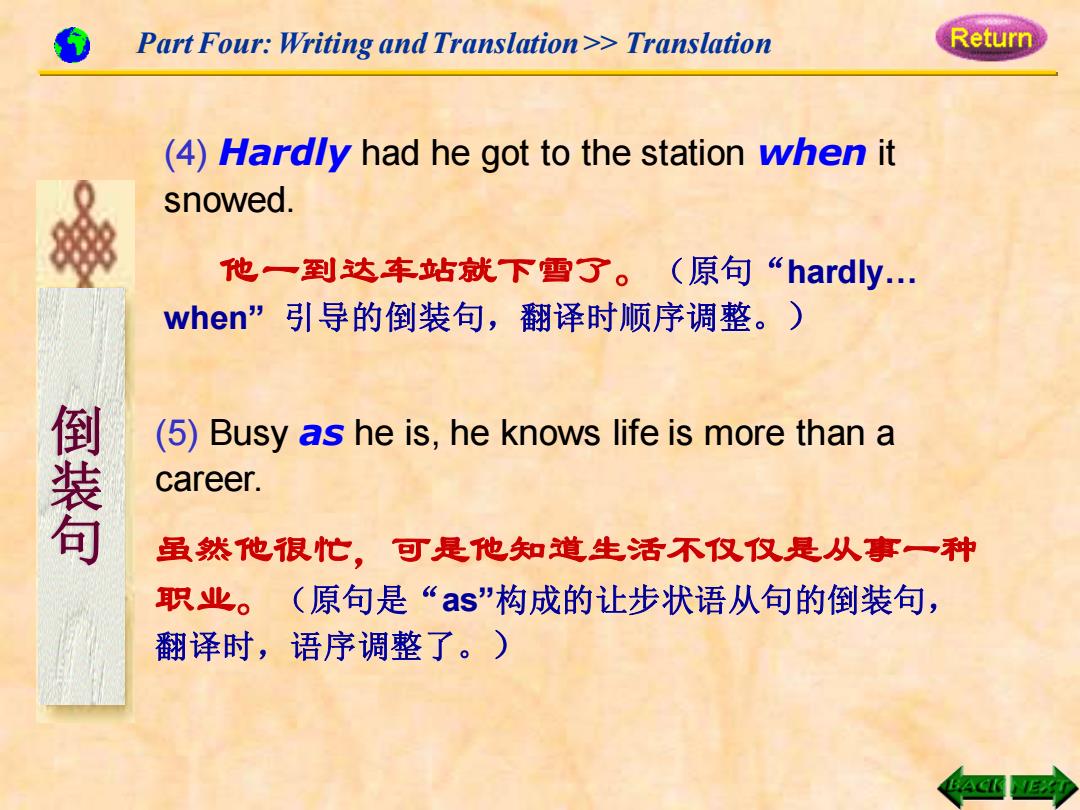
Part Four:Writing and Translation>>Translation Return Knowing About Translation 强调和倒装句型的翻译 英语中需要强调动词时,一般是在动词前面加助 动词do(或do的相应形式),译成汉语时可适当增 加“确实”、“真的”、“一定”等词来表示强调含 强调与强调句型 义 (1)However,they said that they did have six pictures of children that had been used for promotional purposes. 不过,他们说确有六张用于宣传的儿童照片
(1) However, they said that they did have six pictures of children that had been used for promotional purposes. 不过,他们说确有六张用于宣传的儿童照片。 Knowing About Translation Part Four: Writing and Translation >> Translation 强 调 与 强 调 句 型 英语中需要强调动词时,一般是在动词前面加助 动词do (或do的相应形式),译成汉语时可适当增 加“确实” 、 “真的” 、 “一定”等词来表示强调含 义。 强调和倒装句型的翻译

Part Four:Writing and Translation>>Translation Return (2)They did find themselves making faster gear changes,accelerating more quickly and braking more abruptly. 他们的确发现自己换挡更快了,加速也快了, 刹车更急了。 (3)The study demonstrates that cigarette advertising does encourage children to smoke. 该研究表明香烟广告确实起到了鼓动孩子吸烟 的作用
Part Four: Writing and Translation >> Translation (3) The study demonstrates that cigarette advertising does encourage children to smoke. 该研究表明香烟广告确实起到了鼓励孩子吸烟 的作用。 (2) They did find themselves making faster gear changes, accelerating more quickly and braking more abruptly. 他们的确发现自己换挡更快了,加速也快了, 刹车更急了

Part Four:Writing and Translation >Translation Return 些用来强调名词的形容词,或强调形容词的程度 副词,可译成“正是”,“相当”,“就是”等。例如 (1)As well as the type of the music affecting road safety,the very fact that we have high-tech music systems built into our cars also causes accidents. 正如某种音乐会影响行驶安全一样,我们的车里 安装了高技术的音响本身也是引起车祸的根源。 (2)We're terribly fortunate the storm didn't start earlier. 我们相当幸运, 因为暴风雨没有提前到来。 A
Part Four: Writing and Translation >> Translation 一些用来强调名词的形容词,或强调形容词的程度 副词,可译成 “正是” , “相当” , “就是”等。例如: (1) As well as the type of the music affecting road safety, the very fact that we have high-tech music systems built into our cars also causes accidents. 正如某种音乐会影响行驶安全一样,我们的车里 安装了高技术的音响本身也是引起车祸的根源。 (2) We’re terribly fortunate the storm didn’t start earlier. 我们相当幸运,因为暴风雨没有提前到来

Part Four:Writing and Translation>>Translation Return 强调句“tis(was).that (which, who) 可以用来强调句子中的某些成分,如主语、宾语、状语 等。 翻译时可以用 “正是”,“就是”来表示强调含 义。当强调主语时,同强调其他成分一样可以用that; 主语指人时可用who;指物时可用which。 强调句型不 能用于强调谓语和表语 (1)The doctor says:It is the HIV virus that causes AlDS. 医生说正是HIV病毒引起艾滋病的。 A匹
Part Four: Writing and Translation >> Translation 强调句 “It is(was)… that(which, who)…” 可以用来强调句子中的某些成分, 如主语、宾语、状语 等。 翻译时可以用 “正是” , “就是” 来表示强调含 义。当强调主语时,同强调其他成分一样可以用that; 主语指人时可用who; 指物时可用which。 强调句型不 能用于强调谓语和表语。 (1) The doctor says: It is the HIV virus that causes AIDS. 医生说正是HIV病毒引起艾滋病的

Part Four:Writing and Translation>>Translation Return (2)It was at the Cavern,in Liverpool,their home city,that the Beatles's career really began to take off. 甲克虫乐队的音乐生涯却是在他们的家乡利 物浦市的卡文真正开始走红的。 (3)It was on Sunday that Davis felt his loneliness most keenly. 让戴维斯特别强烈地感到孤独的就是星期天
Part Four: Writing and Translation >> Translation (3) It was on Sunday that Davis felt his loneliness most keenly. 让戴维斯特别强烈地感到孤独的就是星期天。 (2) It was at the Cavern, in Liverpool, their home city, that the Beatles’s career really began to take off. 甲克虫乐队的音乐生涯却是在他们的家乡利 物浦市的卡文真正开始走红的

Part Four:Writing and Translation >Translation Return 在某些疑问词如what、where、who、why、how等 后面加上词组,如on earth、in the world、the hel、the devil等,也可以表示强调,一般用于疑问句或否定句。 翻译时可以用“到底”、“究竟”来表示强调。 (1)Where on earth can she be? 她究竟会在哪儿?
Part Four: Writing and Translation >> Translation 在某些疑问词如what、where、who、why、how 等 后面加上词组,如on earth、in the world、the hell、the devil 等,也可以表示强调,一般用于疑问句或否定句。 翻译时可以用“到底” 、 “究竟”来表示强调。 (1) Where on earth can she be? 她究竟会在哪儿?

Part Four:Writing and Translation>>Translation Return (2)What the hell is she doing? 她到底在干什么? (3)How in the world did you go yesterday afternoon? 昨天下午你究竟怎么去的?
Part Four: Writing and Translation >> Translation (3) How in the world did you go yesterday afternoon? 昨天下午你究竟怎么去的? (2) What the hell is she doing? 她到底在干什么?

Part Four:Writing and Translation>>Translation Return 英语和汉语的句子结构中的相似之处在于它们都 遵循主语、谓语和宾语的顺序,但有时由于语法结构 和修辞的需要,英语使用一些倒装句,从而达到突出 某成分和强调语义的效果。翻译这些倒装句时,有时 需要调整词序。 倒装句 (1)Gone were the optimism that they represented and the social consciousness that they spread. 他们所代表的乐观主义精神和他们所传播的社 会意识亦随之而去了。(原句是倒装句,谓语提前, 翻译时,词序调整。)
Part Four: Writing and Translation >> Translation 英语和汉语的句子结构中的相似之处在于它们都 遵循主语、谓语和宾语的顺序,但有时由于语法结构 和修辞的需要, 英语使用一些倒装句,从而达到突出 某成分和强调语义的效果。翻译这些倒装句时,有时 需要调整词序。 (1) Gone were the optimism that they represented and the social consciousness that they spread. 他们所代表的乐观主义精神和他们所传播的社 会意识亦随之而去了。(原句是倒装句,谓语提前, 翻译时,词序调整。) 倒 装 句

Part Four:Writing and Translation>>Translation Return (2)Among the 170 music professionals donating their talents are singer Ronnie Spector and rock star Roger Daltrey,as well as the cast members of the Broadway musical Titanic. 有170位专业音乐人奉献才艺,其中有歌手罗 妮·斯佩克特、摇滚歌星罗杰·多尔特里,以及百老 汇音乐剧《泰坦尼克号》的全体演员。(原句为倒装 句,译成汉语时,基本按照原句语序,不作调整。) (3)Here comes the manager you want to see. 你要见的经理来了。(原句句首是以副词“Here” 开始,翻译时,语序调整。)
(2) Among the 170 music professionals donating their talents are singer Ronnie Spector and rock star Roger Daltrey, as well as the cast members of the Broadway musical Titanic. 有170位专业音乐人奉献才艺,其中有歌手罗 妮·斯佩克特、摇滚歌星罗杰·多尔特里,以及百老 汇音乐剧《泰坦尼克号》的全体演员。(原句为倒装 句,译成汉语时,基本按照原句语序,不作调整。) Part Four: Writing and Translation >> Translation (3) Here comes the manager you want to see. 你要见的经理来了。(原句句首是以 副词“Here” 开始, 翻译时, 语序调整。)

Part Four:Writing and Translation >Translation Return (4)Hardly had he got to the station when it snowed. 他一到达车站就下雪了。(原句“hardly.. when”引导的倒装句,翻译时顺序调整。) 倒装句 (5)Busy as he is,he knows life is more than a career. 虽然他很忙,可是他知道生活不仅仅是从事一种 职业。(原句是“as”构成的让步状语从句的倒装句, 翻译时,语序调整了。)
Part Four: Writing and Translation >> Translation 倒 装 句 (5) Busy as he is, he knows life is more than a career. 虽然他很忙,可是他知道生活不仅仅是从事一种 职业。(原句是“as”构成的让步状语从句的倒装句, 翻译时,语序调整了。) (4) Hardly had he got to the station when it snowed. 他一到达车站就下雪了。(原句“hardly… when” 引导的倒装句,翻译时顺序调整。)